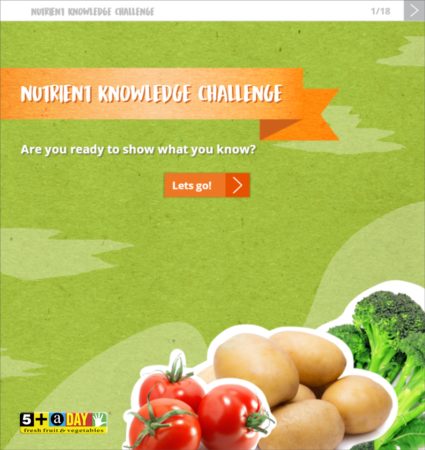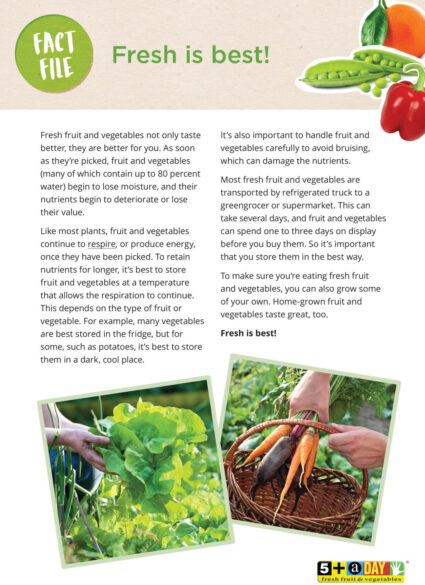Learning Opportunity 3: How can we make sure we get the nutrients our bodies need from fresh fruit and vegetables?
In this learning opportunity, students will explore the importance of eating a variety of nutrients and test the nutrients in different fruit and vegetables. They will undertake an inquiry of their choice to broaden their knowledge and delve more deeply into storing and preparing fresh fruit and vegetables to retain their maximum value.
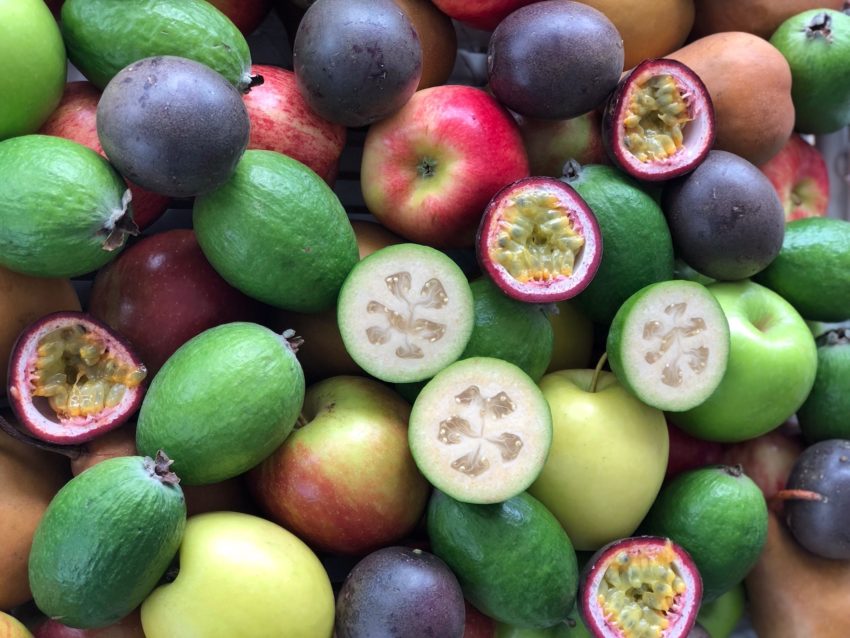
Learning Intentions
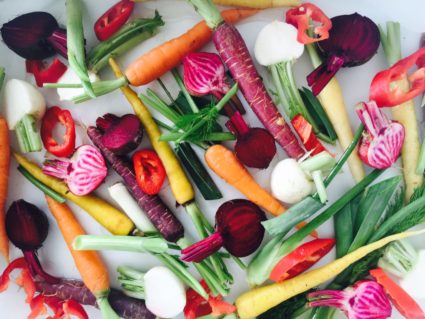
Students will:
- discuss the importance of eating a variety of coloured fruit and vegetables
- investigate the different nutrients in fruit and vegetables
- understand that fruit and vegetables may lose their nutritional value when they are not fresh
- explore ways to store and prepare fresh fruit and vegetables to retain freshness and nutrients
- evaluate current issues and theories of nutrition, identify and reflect on factors that influence people’s choices and behaviours, and use this knowledge to make informed decisions
Possible Achievement Objectives
Health and Physical Education: Level 5
PERSONAL GROWTH AND DEVELOPMENT
Students will:
- describe physical, social, emotional, and intellectual processes of growth and relate these to features of adolescent development and effective self-management strategies
Science: Level 5
LIFE PROCESSES
Students will:
- identify the key structural features and functions involved in the life processes of all plants and animals
Preparation
Materials
For this and other lessons, there is a range of resources to use to prepare for the topic, and where appropriate, to share with students.
- Nutrient Fact Files
- Photo Cards: Basil (1) and Basil (2)
- Fact File: Fresh is best
- Materials for food tests
Key Vocabulary
During this learning opportunity, key terms are used. Click on an underlined word to view a definition. You can define and explore these terms in context as you discuss this topic with your students.
The Learning Opportunity
This learning opportunity contains suggestions for helping students understand the ways we can ensure we get the nutrients we need from fruit and vegetables, and preparing and storing them correctly to ensure they maintain their nutritional value. You can adapt the approach and activities, as needed, to support your students as they carry out their inquiries. Your role is to help your students generate rich questions about the topic of getting the nutrients we need (retaining the nutritional value of fruit and vegetables), rather than simply providing them with information.
Note: As a part of every learning opportunity, you can reinforce the message that eating 5+ A Day fresh fruit and vegetables is an important part of making healthy lifestyle choices.
If your students did not take part in the Nutrient Knowledge Challenge during learning opportunity 1 or 2, you could explore it with them now (click on the image to download and play). If laptops or tablets are available, this can be done in pairs or small groups. Or to involve the whole class, this can be done collaboratively using an IWB. It’s important that you familiarise yourself with this activity prior to taking it with the class. It involves interactivity to engage students in their exploration.
Begin by reviewing Learning Opportunity 2 – Why are the nutrients in fruit and vegetables so important for good health? Ask:
- What are nutrients?
- What’s an example of a vitamin? (vitamin C)
- In what foods is it found? (e.g., citrus, kiwifruit, capsicum, spinach)
Make a list of students’ responses. Do the same for protein (for example, meat, eggs, dairy, beans and legumes), and carbohydrates (for example, potatoes, rice, legumes, pasta).
Tell students that this learning opportunity will focus on how we can make sure we get as many nutrients as possible from fresh fruit and vegetables? Fruit and vegetables are an essential part of a balanced diet, delivering important nutrients such as vitamin C and folate.
Remind students of Michael Pollan’s quote: “Eat food, not too much, mostly plants”, and the importance of eating at least 5+ A Day fresh fruit and vegetables – with meals and snacks and dessert.
Eat your colours
Write the phrase 'Eat your colours' on the board. Ask:
- What do you think 'Eat your colours' means?
You could use the analogy of visiting the fruit and vegetable section at the supermarket.
- What do you notice about the fruit and vegetables on display at the supermarket? (They are a rainbow of colours.)

Then ask:
- Why is it important to eat a range of different coloured fruit and vegetables?
Have students get into pairs or groups and discuss this question. They can then report back to the class. (Brightly coloured fruit and vegetables contain a variety of nutrients that we need to be healthy, so it’s important to eat a range of coloured fruit and vegetables.)
Ask students if they have any questions about coloured fruit and vegetables and write them in a ‘parking lot’ on the board or a flip chart. You could also mention that brightly coloured fruit and vegetables are rich in phytonutrients, many of which are pigments that give them their colour and flavour. For example, the carotenoids that make carrots orange.
Note: Phytonutrients are not actually nutrients but are compounds that may contribute to the health benefits of eating plant-based food. A question for the parking lot (or a potential inquiry question) could explore different kinds of phytonutrients and their potential health benefits.
Kitchen chemistry tests for nutrients in vegetables
If you have time, students could test the content of nutrients in fruit and vegetables like starch and vitamin C. There are simple tests they can do for vitamin C and starch. Click here for a test for vitamin C and here for a test for starch.
Review how the tests went and the students’ results.
- What did you find out?
- What questions do you still have?
Eating fresh fruit and vegetables
Introduce a discussion about the importance of eating fruit and vegetables that are fresh, as opposed to those that have been in the fridge, the cupboard, or on the counter top for a while. It is, however, OK to store some fruit and vegetables, such as apples and potatoes, for a period of time with little loss of nutritional value. However, leafy green vegetables like spinach and lettuce, herbs like basil, as well as many berries deteriorate very quickly.
Show students the Photo Cards: Basil 1, which shows a photograph of a healthy basil plant and Basil 2, which shows a wilted basil plant (click on the image to enlarge and download). Ask:
- What do you notice about the basil in these two photographs? (One looks fresh; the other looks wilted.)
- Which basil would you rather eat?
- What are some of the other signs that fruit and vegetables may not be fresh? (changes in colour from green to yellow or browning, becomes soft, stronger smell, mould, etc.)
- Why do you think is it important to eat fresh vegetables or fruit?
- What do you think happens to the nutrients in fruit and vegetables if they are no longer fresh?
Encourage students to share their ideas, then show them the Fact File: Fresh is best (click on the image to enlarge and download).
After reading the fact file, discuss any questions students have about how we store and prepare fresh fruit and vegetables, which could lead into an inquiry. Place any potential inquiry questions in the ‘parking lot.’
Student inquiries
Based on the students’ experiences and conversation in this lesson, ask them to think of questions that will extend their understanding and act as the focus for an inquiry that they can take on independently or in pairs. They could choose to use a question from the parking lot if it is rich enough to support an inquiry.
Whatever students choose to do, they need to use a rich, open question as a catalyst, and aim to present their findings to the class clearly and concisely. The intention is that these activities can be undertaken outside of class time and presented at the beginning of the next learning opportunity.
Diving Deep
Students could investigate how we can ensure that the food we eat is fresh and has the maximum amount of nutrients. They can formulate questions around the areas they want to investigate, for example:
- What are the best ways to store different fruit and vegetables to keep them fresh and retain their maximum nutritional value?
- What are the best ways to prepare/cook fruit and vegetables to retain their maximum nutritional value?
Storage: Do we need to keep all fruit and vegetables in the fridge? For example, it’s usually recommended to keep tomatoes at room temperature to retain their flavour. You can find more information about storing fruit and vegetables at 5+ A Day here.
Preparation: Have a conversation about raw and cooked fruit and vegetables. Most fruit is eaten fresh. What happens when you cook fruit? What happens when you cook vegetables?
Students can use the sources on the information hub, as well as that from their own research on the internet. Encourage them to report back to the class in innovative ways, for example, a speech or debate, a blog, or a video clip.
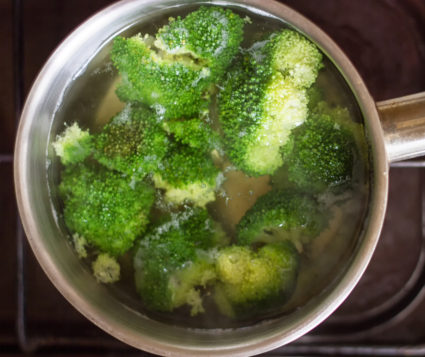
Reflection
To finish, allow time to reflect on the learning outcomes and to talk and share ideas that are still unclear.
In reflecting on this learning opportunity, the discussion will focus on:
- the importance of eating your colours
- what happens to nutrients when fruit and vegetables are no longer fresh
- how we can store and prepare vegetables for maximum nutrition
If there is time, explain that the next learning opportunity will focus on how we find out about the nutritional content of fruit and vegetables, and the rules around the health and nutritional messages producers can give.
